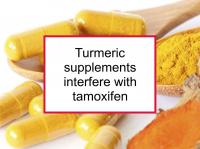Turmeric is a bright yellow spice made from the dried rhizome (underground stem) of the plant Curcuma longa. It contains several curcuminoids, including curcumin. However, the bioavailability of the curcumin in turmeric when consumed in food is somewhat limited due to poor absorption and rapid elimination from the body.
This limited bioavailability is part of the motivation for taking supplements with relatively high levels of curcuminoids. However, note that relatively high doses of such supplements have been reported to induce liver damage.
There is abundant cell and animal study evidence that the curcumin found in turmeric has anti-cancer properties against both estrogen responsive (ER+) and ER- breast cancer. However, when a beneficial micronutrient such as curcumin is consumed at low doses in food, it normally has subtle chemopreventive effects, whereas when the same micronutrient is taken in high doses, it is more likely to have pharmacological (drug-like) effects. These can sometimes produce adverse outcomes. This appears to be the case for the combination of tamoxifen with turmeric or curcumin supplements. We recommend against taking such supplements during tamoxifen treatment.
Turmeric contains phytoestrogens
Turmeric contains a number of curcuminoids, including curcumin, bismethoxycurcumin, and demethoxycurcumin, each of which have been shown to act as phytoestrogens. In other words, these compounds are structurally and functionally similar to mammalian estrogens and can bind to estrogen receptors. This estrogenic activity has been demonstrated in cell studies; curcumin can induce estradiol-regulated gene expression in ER+/PR+ breast cancer cells.
However, when phytoestrogens bind to cell receptors, they can have either anti-cancer activity (which reduces ER+ cell proliferation and growth), or cancer promoting activity (increasing ER+ cell proliferation and growth), or both (depending primarily on dosage). Based on available evidence, the phytoestrogens in turmeric are associated with reduced ER+ breast cancer risk. The case against taking turmeric or curcumin supplements with tamoxifen does not rest on their estrogenic properties. We summarize the cases for and against using such supplements during tamoxifen treatment below.
The case for turmeric use during tamoxifen treatment
Several cell studies have reported that curcumin (the curcuminoid with the strongest anti-cancer effects) can increase the bioavailability of tamoxifen, counteract tamoxifen resistance, and potentiate the treatment effects of tamoxifen.
Curcumin counteracts tamoxifen resistance
Tamoxifen resistance appears to depend in part on the aberrant activation of growth factor signaling pathways. Breast cancer cell lines with such resistance are characterized by high levels of the pro-survival transcription factor NF-kB. Curcumin has been shown to inhibit the activation of NF-kB and other relevant pathways in ER+/PR+ breast cancer cells, thereby sensitizing them to tamoxifen treatment.
The expression of multidrug resistance mRNA was shown to be suppressed in ER+/ER+ cells co-treated with tamoxifen and curcumin in one study. In fact, co-treatment with curcumin and tamoxifen has been found to synergistically inhibit survival in tamoxifen-resistant ER+/PR+ cells in several studies.
The case against turmeric use during tamoxifen treatment
Cell and animal studies have reported that curcumin reduces the treatment effects of tamoxifen by interfering with its metabolism.
Curcumin inhibits CYP3A4 metabolism of tamoxifen
Tamoxifen and curcumin both interact with the cytochrome P450 3A4 (abbreviated CYP3A4) enzyme, found mainly in the liver and small intestine, which oxidizes certain toxins and drugs in order to eliminate them from the body. Curcumin appears to inhibit the CYP-mediated metabolism of tamoxifen to its active metabolite, 4-hydroxytamoxifen.
In one animal study, rats were divided into groups that were administered either tamoxifen alone or tamoxifen plus curcumin. The addition of curcumin was found to significantly inhibit CYP3A4 activity, resulting in reduction of the metabolism of tamoxifen to 4-hydroxytamoxifen.
Curcumin reduces binding affinity of tamoxifen to HSA
The binding of drugs to human serum albumin (HSA) helps determine the therapeutic dosage and effects of certain drugs. HSA has been shown to act as a carrier protein for tamoxifen and its metabolites, delivering them to target tissues. Curcumin appears to compete for the binding site of tamoxifen in the tertiary structure of HSA. One study used fluorescence spectroscopy to identify two tamoxifen binding sites in HSA. The binding affinity of tamoxifen to HSA was found to be reduced in the presence of curcumin.
Curcumin interfered with tamoxifen metabolism in human study
The authors of a 2018 study decided to test the theory that curcumin would increase the output of endoxifen, a primary metabolite of tamoxifen, in a randomized, 3-phase, cross-over study. Several previous studies had reported that piperine (the most beneficial bioactive compound in black pepper) enhanced the anti-cancer effects of curcumin. Based on these findings, the authors added piperine to the experiment as a "bioenhancer." The authors were surprised to find that both curcumin alone and curcumin plus piperine reduced the exposure to tamoxifen and endoxifen in the female study participants. The authors concluded that co-treatment with curcumin and piperine could reduce endoxifen levels below the threshold for tamoxifen treatment efficacy.
Sources of information provided in this webpage
The information above, which is updated continually as new research becomes available, has been developed based solely on the results of academic studies. Clicking on any of the underlined terms will take you to its tag or webpage, which contain more extensive information.
